Ikat is a dyeing technique originated from Indonesia used to pattern textiles that employs resist dyeing on the yarns prior to dyeing and weaving the fabric.

Kasuri (絣) is the Japanese term for fabric that has been woven with fibers dyed specifically to create patterns and images in the fabric, typically referring to fabrics produced within Japan using this technique. It is a form of ikat dyeing, traditionally resulting in patterns characterized by their blurred or brushed appearance.
Maya textiles are the clothing and other textile arts of the Maya peoples, indigenous peoples of the Yucatán Peninsula in Mexico, Guatemala, Honduras, El Salvador and Belize. Women have traditionally created textiles in Maya society, and textiles were a significant form of ancient Maya art and religious beliefs. They were considered a prestige good that would distinguish the commoners from the elite. According to Brumfiel, some of the earliest weaving found in Mesoamerica can date back to around 1000-800 B.C.E.
The manufacture of textiles is one of the oldest of human technologies. To make textiles, the first requirement is a source of fibre from which a yarn can be made, primarily by spinning. The yarn is processed by knitting or weaving, which turns yarn into cloth. The machine used for weaving is the loom. For decoration, the process of colouring yarn or the finished material is dyeing. For more information of the various steps, see textile manufacturing.

African textiles are textiles from various locations across the African continent. Across Africa, there are many distinctive styles, techniques, dyeing methods, and decorative and functional purposes. These textiles hold cultural significance and also have significance as historical documents of African design.
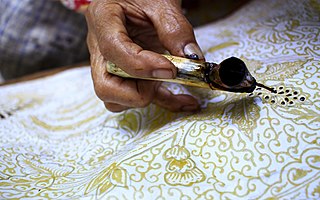
Resist dyeing (resist-dyeing) is a traditional method of dyeing textiles with patterns. Methods are used to "resist" or prevent the dye from reaching all the cloth, thereby creating a pattern and ground. The most common forms use wax, some type of paste made from starch or mud, or a mechanical resist that manipulates the cloth such as tying or stitching. Another form of resist involves using a chemical agent in a specific type of dye that will repel another type of dye printed over the top. The best-known varieties today include tie-dye, batik, and ikat.

The Sompot, a long, rectangular cloth worn around the lower body, is a traditional dress in Cambodia. It can be draped and folded in several different ways. The traditional dress is similar to the dhoti of Southern Asia. It is also worn in the neighboring countries of Laos and Thailand where it is known as pha nung.
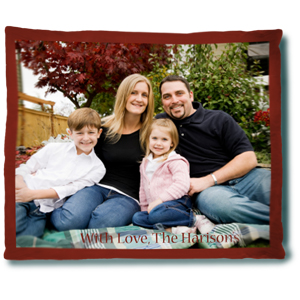
A photo blanket is a large, rectangular piece of fabric displaying images, pictures, or designs, often with bound edges, used as a blanket or decorative object. Historically photo blanket were made of thick cloth depicting people, objects, and symbols intended to tell a story or reveal historical events.

Tapis is a traditional weaving style and also refers to resulting cloth that originated from Lampung, South Sumatra, Indonesia. It consists of a striped, naturally-coloured cloth embroidered with warped and couched gold thread. Traditionally using floral motifs, it has numerous variations. It is generally worn ceremonially, although it can be used as a decoration. It is considered as one of the symbols of Lampung and Lampungese.

A Sambalpuri sari is a traditional handwoven ikat or sari wherein the warp and the weft are tie-dyed before weaving. It is produced in the Sambalpur, Balangir, Bargarh, Boudh and Sonepur districts of Odisha, India. The sari is a traditional female garment in the Indian subcontinent consisting of a strip of unstitched cloth ranging from four to nine metres in length that is draped over the body in various styles.

Siripuram is a village and a gram panchayat of Ramannapet Mandal, Nalgonda District, in Telangana state.
Described by generations of foreign ethnographers and collectors as "ship cloths" because of the predominance of a ship motif, they were said to represent the "ship of the dead." In Sumatra these cloths are also called sesai balak. No convincing field data were ever collected from 19th century weavers or traditional owners about the iconography. Since then, there has been great loss of Lampung traditional knowledge. The history of these ships cloth is obscure and the reasons for both their original use and their decline remain conjectural.. The factors that are presumed to have caused this include the abolition of slavery in 1859, the decline in the pepper trade and changing marriage traditions. Two lesser known forms are the tatibin and the tampan maju. The tatibin are similar in design to the single ship palepai but are smaller, not exceeding 1.5 M. The tampan maju beaded and also shorter than the large cloths. Only 12 examples of tampan maju are known to exist.
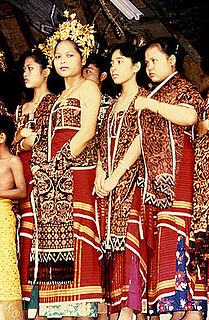
Balinese textiles are reflective of the historical traditions of Bali. Bali has been historically linked to the major courts of Java before the 10th century; and following the defeat of the Majapahit kingdom, many of the Javanese aristocracy fled to Bali and the traditions were continued. Bali therefore may be seen as a repository not only of its own arts but those of Java in the pre-Islamic 15th century. Any attempt to definitively describe Balinese textiles and their use is doomed to be incomplete. The use of textile is a living tradition and so is in constant change. It will also vary from one district to another. For the most part old cloth are not venerated for their age. New is much better. In the tropics cloth rapidly deteriorates and so virtue is generated by replacing them.

Geringsing is a textile created by the double ikat method in the Bali Aga village of Tenganan Pegeringsingan in Bali. The demanding technique is only practiced in parts of India, Japan and Indonesia. In Indonesia it is confined to the village of Tenganan.

Patola is a double ikat woven sari, usually made from silk, made in Patan, Gujarat, India. The word patola is the plural form; the singular is patolu. They are very expensive, once worn only by those belonging to royal and aristocratic families. These saris are popular among those who can afford the high prices. Velvet patola styles are also made in Surat. Patola-weaving is a closely guarded family tradition. There are three families in Patan that weave these highly prized double ikat saris. It is said that this technique is taught to no one in the family, but only to the sons. It can take six months to one year to make one sari due to the long process of dying each strand separately before weaving them together. Patola was woven in Surat, Ahmedabad and Patan. Highly valued in Indonesia, became part of the local weaving tradition there.

This early twentieth century woman's ceremonial skirt from the Indonesian island of Sumba is part of the textiles collection of the Indianapolis Museum of Art, which is in Indianapolis, Indiana. Also known as a lau hada, the skirt would have been a nuptial gift for a woman of great social standing, since it is made of imported, machine-woven cotton cloth, glass trade beads, and nassa shells, which were once used as currency.

The Sumba people are an ethnic group inhabiting Sumba Island, which is divided by two regencies, namely West Sumba Regency and East Sumba Regency. They refer to themselves as Tau Humba. The Sumbese have been able to retain much of their culture despite foreign influences that arrived long ago on the Lesser Sunda Islands.
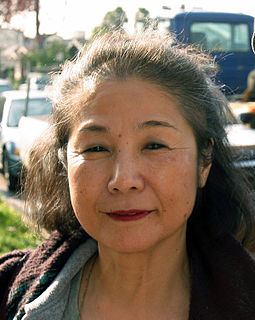
Yoshiko Iwamoto Wada is a Japanese textile artist, curator, researcher and author.

Odisha Ikat is a kind of ikat, a resist dyeing technique, originating from Indian state of Odisha, adapted from ikat in Indonesia. Also known as "Bandha of Odisha", it is a geographically tagged product of Odisha since 2007. It is made through a process of tie-dying the warp and weft threads to create the design on the loom prior to weaving. It is unlike any other ikat woven in the rest of the country because of its design process, which has been called "poetry on the loom". This design is in vogue only at the western and eastern regions of Odisha; similar designs are produced by community groups called the Bhulia, Kostha Asani, and Patara. The fabric gives a striking curvilinear appearance. Saris made out of this fabric feature bands of brocade in the borders and also at the ends, called anchal or pallu. Its forms are purposefully feathered, giving the edges a "hazy and fragile" appearance. Ikat's equivalent usage in Malay-Indonesian language is ikat or mengikat, which means "to tie or to bind".
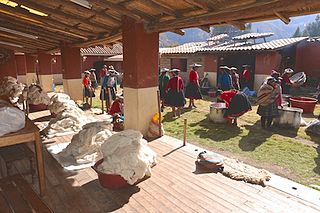
Centro de Textiles Tradicionales del Cusco was founded by indigenous weavers from the community of Chinchero as well as international supporters in 1996 as a non-profit organization. It is based out of the city of Cusco, Peru where its main offices, museum and shop are located. The CTTC works in support of indigenous weavers from the Cusco region to recover traditional Cusqueñan textiles. The organization currently partners with ten communities from the Cusco region: Accha Alta, Acopia, Chahuaytire, Chinchero, Huacatinco, Mahuaypampa, Patabamba, Pitumarca, Santa Cruz de Sallac, and Santo Tomas (Chumbivilcas).



















